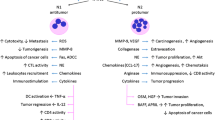Abstract
Polymorphonuclear neutrophil (PMN) function is thought to be critical in resistance to infectious agents and this implies that the PMN must be able to migrate into, and to function in, environments that may have high levels of bacterial lipopolysaccharide (LPS). Therefore, we have evaluated the effect of LPS on the in vitro migration of PMNs. Our data reveal that the human PMN is resistant to the deleterious effects of high levels of LPS, that in high concentrations LPS is, itself, a direct chemoattractant for PMNs, and that PMN migration toward a bacterial chemotaxin is enhanced if LPS is also present. Such capabilities suggest that the PMN may be uniquely qualified to migrate into microenvironments that are rich in LPS.
Similar content being viewed by others
References
Boyum, A. 1968. Isolation of mononuclear cells and granulocytes from human blood.Scand. J. Lab. Invest. 21(suppl):77–89.
Creamer, H.R., W.L. Gabler, andW.W. Bullock. 1983. Endogenous component chemotactic assay (ECCA).Inflammation 7:321–329.
Gabler, W.W., H.R. Creamer, andW.W. Bullock. 1986. Modulation of the kinetics of induced neutrophil superoxide generation by fluoride.J. Dent. Res. 65:1159–1165.
Milner, K.C., J.A. Rudbach, andE. Ribi. 1971. General characteristics.In Microbial Toxins, Vol. IV, Bacterial Endotoxins. G. Weinbaum, S. Kadis and S.J. Ajl, editors. Academic Press, New York. 1–65.
Issekutz, A.C. 1983. Removal of gram-negative endotoxin from solutions by affinity chromatography.J. Immunol. Methods 61:275–281.
Pugliese, C., M.D. LaSalle, andV.A. DeBari. 1988. Relationships between the structure and function of lipopolysaccharide chemotypes with regard to their effects on the human polymorphonuclear neutrophil.Mol. Immunol. 25:631–637.
Dahinden, C., C. Galanos, andJ. Fehr. 1983. Granulocyte activation by endotoxin I. Correlation between adherence and other granulocyte functions, and role of endotoxin structure on biologic activity.J. Immunol. 130:857–862.
Snyderman, R., H. Gewurz, andS.E. Mergenhagen. 1968. Interactions of the complement system with endotoxic lipopolysaccharide.J. Exp. Med. 128:259–275.
Issekutz, A.C., andS. Bhimji. 1982. Role for endotoxin in the leukocyte infiltration accompanyingEscherichia coli inflammation.Infect. Immun. 36:558–566.
Moeller, G.R., L. Terry, andR. Snyderman. 1978. The inflammatory response and resistance to endotoxin in mice.J. Immunol. 120:116–123.
Kotani, S., H. Takada, M. Tsujimoto, et al. 1985. Synthetic lipid A with endotoxic and related biological activities comparable to those of a natural lipid A from anEscherichia coli Re-mutant.Infect. Immun. 49:225–237.
Bogar, L., Z. Molnar, andM. Tekeres. 1988. A new simplified assay for evaluation of motile activity of human polymorphonuclear leucocytes.Immunol. Lett. 17:211–216.
Haslett, C., L.A. Guthrie, M.M. Kopaniak, R.B. Johnston, andP.M. Henson. 1985. Modulation of multiple neutrophil functions by preparative methods or trace concentrations of bacterial lipopolysaccharide.Am. J. Pathol. 119:101–110.
Wright, G.G., andG.L. Mandell. 1986. Anthrax toxin blocks priming of neutrophils by lipopolysaccharide and by muramyl dipeptide.J. Exp. Med. 164:1700–1709.
Forehand, J.R., M.J. Pabst, W.A. Philips, andR.B. Johnston, Jr. 1989. Lipopolysaccharide priming of human neutrophils for an enhanced respiratory burst — role of intracellular free calcium.J. Clin. Invest. 83:74–83.
Vosbeck, K., P. Tobias, H. Mueller, et al. 1990. Priming of polymorphonuclear granulocytes by lipopolysaccharides and its complexes with lipopolysaccharide binding protein and high density lipoprotein.J. Leukocyte Biol. 47:97–104.
Murphy, P., andD.A. Hart. 1987. Regulation of enzyme release from human polymorphonuclear leukocytes: Further evidence for the independent regulation of granule subpopulations.Biochem. Cell Biol. 65:1007–1015.
Doerfler, M.E., R.L. Danner, J.H. Shelhamer, andJ.E. Parrillo. 1989. Bacterial lipopolysaccharides prime human neutrophils for enhanced production of leukotriene B4.J. Clin. Invest. 83:970–977.
Bremm, K.D., W. Konig, M. Thelestam, andJ.E. Alouf. 1987. Modulation of granulocyte functions by bacterial exotoxins and endotoxins.Immunology 62:363–371.
Issekutz, A.C., andW.D. Biggar. 1977. Influence of serum-derived chemotactic factors and bacterial products on human neutrophil chemotaxis.Infect. Immun. 15:212–220.
Henricks, P.A.J.,M.E. Van der Tol, R.W.W.M. Thyssen, B.S. Van Asbeck, andJ. Verhoef. 1983.Escherichia coli lipopolysaccharides diminish and enhance cell function of human polymorphonuclear leukocytes.Infect. Immun. 41:294–301.
Klinkhamer, J.M. 1968. Quantitative evaluation of gingivitis and periodontal disease I. The orogranulocytic migratory rate.Periodontics 6:207–211.
Tempel, T.R., R. Snyderman, H.V. Jordan, andS.E. Mergenhagen. 1970. Factors from saliva and oral bacteria, chemotactic for polymorphonuclear leukocytes: Their possible role in gingival inflammation.J. Periodontol. 41:71–80.
Shapiro, L., F.M. Lodato, P.R. Courant, andR.E. Stallard. 1972. Endotoxin determinations in gingival inflammation.J. Periodontol. 43:591–596.
Simon, B., H. Goldman, M, Ruben, andE. Baker. 1971. The role of endotoxin in periodontal disease. III. Correlation of the quantity of endotoxin in human gingival exudate with the clinical degree of infanimation.J. Periodontol. 42:210–216.
McCoy, S.A., H.R. Creamer, M. Kawanami, andD.F. Adams. 1987. The concentration of lipopolysaccharide on individual root surfaces at varying times following in vivo root planing.J. Periodontol. 58:393–399.
Hall, C.L., andR.S. Munford. 1983. Enzymatic deacylation of the lipid A moeity ofSalmonella typhimurium lipopolysaccharides by human neutrophils.Proc. Natl. Acad. Sci. U.S.A. 80:6671–6675.
Dal Nogare, A.R., andW.C. Yarbrough, Jr. 1990. A comparison of the effects of intact and deacylated lipopolysaccharide on human polymorphonuclear leukocytes.J. Immunol. 144:1404–1410.
Author information
Authors and Affiliations
Rights and permissions
About this article
Cite this article
Creamer, H.R., Hunter, N., Bullock, W.W. et al. Concurrent lipopolysaccharide enhances chemotactic response of human polymorphonuclear leukocytes to bacterial chemotaxin. Inflammation 15, 201–211 (1991). https://doi.org/10.1007/BF00918646
Issue Date:
DOI: https://doi.org/10.1007/BF00918646




